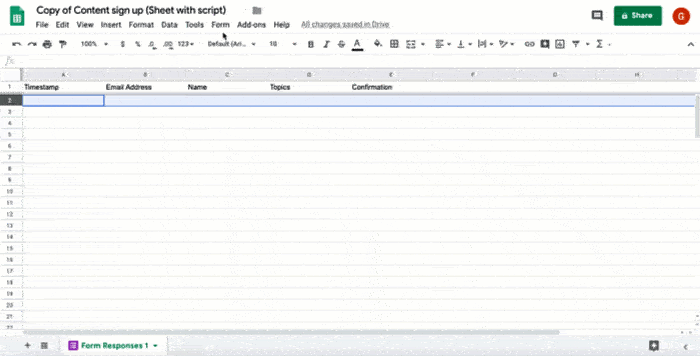Livello di programmazione: principiante
Durata: 20 minuti
Tipo di progetto: automazione con un
trigger basato sugli eventi
Obiettivi
- Comprendi cosa fa la soluzione.
- Scopri cosa fanno i servizi Apps Script all'interno della soluzione.
- Configura lo script.
- Esegui lo script.
Informazioni su questa soluzione
Se hai vari tipi di contenuti da offrire al tuo pubblico, puoi consentire agli utenti di scegliere quali contenuti ricevere da te con Google Moduli. Questa soluzione consente agli utenti di selezionare gli argomenti che interessano loro, quindi invia automaticamente via email i contenuti scelti.


Come funziona
Lo script installa un trigger basato sugli eventi che viene eseguito ogni volta che un utente invia un modulo. A ogni invio del modulo, lo script crea e invia un'email da un modello di Documenti Google. L'email include il nome dell'utente e i contenuti che ha selezionato. I contenuti che offri possono essere di qualsiasi tipo, purché faccia riferimento a un URL.
Servizi Apps Script
Questa soluzione utilizza i seguenti servizi:
- Servizio script: installa il trigger basato su eventi che viene attivato ogni volta che qualcuno invia il modulo.
- Servizio documenti: apre il modello di Documenti che lo script utilizza per creare l'email.
- Servizio di posta: crea e invia l'email con il nome dell'utente e la selezione dei contenuti.
- Servizio Fogli: aggiunge una conferma al foglio Risposte del modulo dopo che lo script invia l'email.
Prerequisiti
Per utilizzare questo esempio, devi soddisfare i seguenti prerequisiti:
- Un Account Google (gli account Google Workspace potrebbero richiedere l'approvazione dell'amministratore).
- Un browser web con accesso a internet.
Configurare lo script
Fai clic sul pulsante seguente per creare una copia del foglio di lavoro Invia contenuti selezionati. Il progetto Apps Script per questa soluzione è allegato al foglio di lavoro.
Crea una copiaNel foglio di lavoro copiato, fai clic su Estensioni > Apps Script.
Nel menu a discesa della funzione, seleziona installTrigger.
Fai clic su Esegui.
Quando ti viene richiesto, autorizza lo script. Se nella schermata per il consenso OAuth viene visualizzato l'avviso Questa app non è verificata, continua selezionando Avanzate > Vai a {Project Name} (non sicuro).
Importante: se esegui installTrigger più di una volta, lo script crea più trigger che inviano un'email ogni volta che un utente invia il modulo. Per eliminare gli attivatori aggiuntivi ed evitare email duplicate, fai clic su Attivatori . Fai clic con il tasto destro del mouse su ogni trigger aggiuntivo e fai clic su Elimina trigger.
Esegui lo script
- Torna al foglio di lavoro e fai clic su Strumenti > Gestisci modulo > Vai al modulo live.
- Compila il modulo e fai clic su Invia.
- Controlla la tua email per trovare un messaggio con i link ai contenuti che hai selezionato.
Esamina il codice
Per esaminare il codice Apps Script per questa soluzione, fai clic su Visualizza codice sorgente di seguito:
Visualizza codice sorgente
Code.gs
Collaboratori
Questo esempio è gestito da Google con l'aiuto degli esperti Google.
